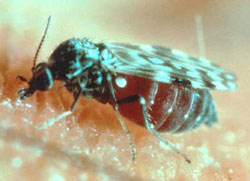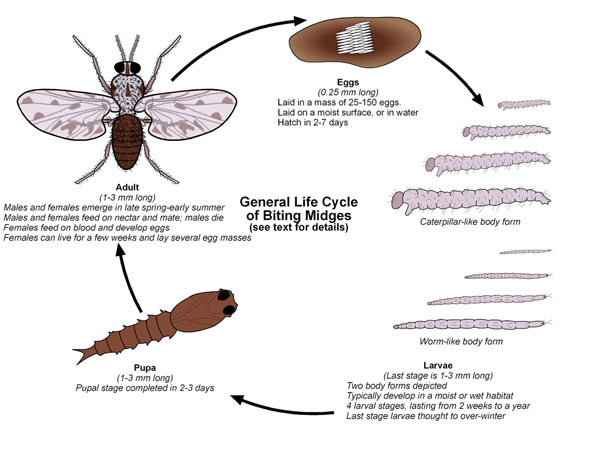
Insects and Ticks > Biting Midges
Biting midges are minute to tiny flies that can be severe biting pests of humans, pets, livestock, and wildlife. Their blood-sucking habits also raise concerns about possible involvement in the transmission of disease agents. You are encouraged to learn more about the biology of biting midges so that you can avoid being bitten and be better informed about their public health risk.
Are Biting Midges a Public Health Risk?
Biting midges are extremely annoying, but none are known to transmit disease agents to humans in the U.S. They have a much greater impact on non-human animals, both as biting pests and vectors of disease agents. In North America, the most important disease agent transmitted by biting midges is Blue Tongue virus. This virus is a major cause of disease in livestock in the western U. S., but it does not infect humans.
The bites of biting midges inflict a burning sensation and can cause different reactions in humans, ranging from a small reddish welt at the bite site to local allergic reactions that cause significant itching. When numerous, biting midges have a real impact on residents and visitors of the Atlantic Coast, Gulf Coast, San Francisco Bay region, and southwestern deserts, primarily by limiting outdoor activities.
Biting midge is a common name for pest species, but it is not the only one. For example, “no-see-ums” is used widely in the North America, “punkies” in the Northeast, “five-O’s (related to biting around 5 PM) in Florida and Alabama, “pinyon gnats” in the Southwest, and “moose flies” in Canada.
How Many Types of Biting Midges Are There?
Biting midges are flies (Order Diptera) in the family Ceratopogonidae, which includes over 4, 000 species in 78 genera worldwide. Over 600 species in 36 genera have been described in North America, the vast majority of which either feed on other insects or other non-human animals. Species in only four genera of biting midges feed on the blood of mammals. The genera of greatest importance to human and livestock health in the U. S. are Culicoides, Leptoconops, and Forcipomyia. Very little information exists regarding biting midges in Indiana, but distribution data reveal that several species occur in the state.
The common name "sand fly" at times is applied to members of the biting midge family Ceratopogonidae and the black fly family Simuliidae, but it usually is reserved for blood-sucking species in the subfamily Phlebotominae of the family Psychodidae. There are an estimated 600 species of phlebotomine sand flies in the world, including 14 species in the U. S. Only one of these species bites humans, and it is not known to be involved in the transmission of disease agents.
Phlebotomine sand flies are known to be vectors of viruses, bacteria, and protozoa that cause human disease in Asia, Africa, southern Europe, and Latin America. Their most important involvement is the transmission of protozoan species in the genus Leishmania. Depending on the species and region in which they are transmitted, Leishmania parasites can cause a serious disease known as "visceral leishmaniasis" or "Kala-Azar" plus several forms of disfiguring skin diseases collectively known as "cutaneous leishmaniasis."
 Figure 1. Adult biting midge, Culicoides sonorensis (Wirth and Jones), showing blood-filled abdomen and the characteristic wing patterns used for species identification. (Photo credit: Ed T. Schmidtmann, USDA/ARS)
Figure 1. Adult biting midge, Culicoides sonorensis (Wirth and Jones), showing blood-filled abdomen and the characteristic wing patterns used for species identification. (Photo credit: Ed T. Schmidtmann, USDA/ARS)
How Can I Recognize a Biting Midge?
Biting midges are very small, ranging in size from 1-3 mm in length. They typically are grayish, but more reddish when filled with blood. Wings of many species, including some that feed on humans, contain dark patterns, which give them a grayish appearance (Figure 1). The mouthparts of biting midges consist of a fleshy sheath inside of which are four, minute cutting blades that lacerate the skin, inflicting sharp, burning pain. Observant victims may notice tiny red “spots” that are biting midges filling with blood.
The majority of biting midge larvae resemble tiny, whitish “worms,” but those of certain species resemble miniature caterpillars that possess fleshy processes and “false legs” along the length of their bodies (Figure 2). Visible only with a microscope, biting midge larvae possess a pigmented head capsule and minute chewing mouthparts. Equally tiny, biting midge pupae resemble those of numerous related flies (Figure 2).
What Is the Life Cycle of Biting Midges?
Biting midges undergo a type of development known as “complete metamorphosis.” This means the last larval stage molts into a non-feeding pupal stage that eventually transforms into a winged adult. Relatively few species have been studied, and the account below is based largely on pest species that have been reared in captivity.
 Figure 2. Biting midge life cycle. (Illustration by: Scott Charlesworth, Purdue University,
Figure 2. Biting midge life cycle. (Illustration by: Scott Charlesworth, Purdue University, based in in part on Pechuman, L.L. and H.J. Teskey, 1981, IN: Manual of Nearctic Diptera, Volume 1)
Females typically require a blood meal for development of eggs, but those of a few species are capable of producing an initial batch of eggs without feeding. Eggs are laid in a mass on various moist surfaces and hatch in 2-7 days. There are four larval stages (Figure 2), with larval development completed in about two weeks to a year or more, depending on temperature and food supply. The pupal stage typically is formed in the same site as the last larval stage, and adults emerge in 2-3 days. Adults can live for two to seven weeks. Laboratory and field studies suggest that biting midges may complete two or more generations per calendar year. Last stage larvae over-winter and pupate the following spring to early summer.
Biting midge larvae develop in a variety of semi-aquatic or aquatic habitats, depending on the species. For example, larvae of some species of Culicoides are truly aquatic, developing both in streams and ponds, but those of most species are found in organically rich, semi-aquatic sites such as marshes, bogs, tree holes, and saturated rotting wood. Larvae of Culicoides species that are biting pests of livestock develop in saturated soil of wastewater ponds and sepage from watering troughs, both typically enriched with livestock manure. Larvae of Leptoconops species that bite humans develop in moist soil fissures, including in many areas of the arid western U. S. Larvae of Forcipomyia species develop in mosses, algae, rotting logs, and also in moist soil beneath fecal pats of cattle.
What Should I Know About the Feeding Habits of Adult Biting Midges?
Male and female biting midges feed on plant sap and nectar, the primary energy sources for flight and for increased longevity of females. Egg production requires a protein source, which is obtained either from the body fluids of small insects or vertebrate blood. Male biting midges are not attracted to vertebrates, and their mouthparts are not capable of biting.
Females of pest species feed primarily on mammals, but birds, reptiles, and amphibians also are a source of blood meals. Some species are host specific, but others are opportunistic, feeding on a variety of vertebrates that they encounter, usually in response to carbon dioxide emitted by the host. Different species of biting midges have their peak feeding periods at different times of the day. For example, females of Leptoconops species feed during daylight. In contrast, females of Culicoides species typically do not begin to feed until dusk, and they continue feeding at night. Species of Culicoides that are major biting pests of humans are attracted to light and readily enter dwellings to feed.
Females of an important biting pest (Leptoconops kertszi) in semiarid regions of the southwest are known to disperse up to approximately 10 miles and can affect humans far from the site of larval development. In contrast, females of most species of Culicoides typically disperse no more than .5-1 mile from the site of larval development. In general, biting midges are weak fliers, and flight is greatly reduced or curtailed in windy conditions.
Do Humans Influence Biting Midge Abundance?
Humans have little or no influence over the vast majority of species of biting midges because the larvae develop in “natural habitats” mentioned above. A significant exception to this generalization pertains to certain species of Culicoides that are biting pests of livestock and vectors of Blue Tongue virus. For example, larvae of C. sonorensis develop in tremendous numbers in wastewater evaporation ponds associated with livestock production and also can be abundant in feces-contaminated mud associated with leaking watering troughs.
The feeding habits of relatively very few species of Ceratopogonidae have been studied in detail, but females of some are known to be predators, feeding on the body fluids of small insects that they capture. Larvae of some species of Ceratopogonidae also are known to be predators, feeding on protozoa, small worms, and tiny larvae of insects. Others are thought to feed on bacteria, fungi, algae, and other organic matter. Very few species have been reared under laboratory conditions, in large part because the food sources are unknown. Successful rearing has been limited to several pest species in the genus Culicoides, with the larvae being reared on nematode worms.
Can Biting Midges Be Controlled?
Control of biting midge larvae and adults is very difficult. The only species that can be controlled in the larval stages is C. sonorensis, a species associated with livestock production. Larval development is disrupted by modifying the bank structure of the wastewater ponds, the periodic altering of water levels, and the reduction of leakage from watering troughs.
Suppressing adult biting midges with insecticides has enjoyed limited success, and only under certain conditions. For example, temporary relief has followed aerial application of insecticides along the Atlantic Coast and Gulf Coast during evening hours, when biting midges are most active. However, the installation of window and door screens consisting of a mesh size smaller than normal window screen is much more effective in reducing bites because screens prevent female biting midges from entering dwellings. Similarly, people camping in the certain areas of the western U. S. should use tents outfitted with “biting midge screening” that consists of a mesh size smaller than normal window screening.
Repellents containing DEET (diethytoluamide) and clothing impregnated with DEET or permethrin provide only limited protection. Scheduling outdoor activities to avoid daily peaks of biting midges is the most effective way people can avoid being bitten.
Where Can I Find More Information on Biting Midges?
A recent (2002) textbook by G. Mullen and L. Durden, Medical and Veterinary Entomology, has an excellent chapter devoted to biting midges that covers biology, behavior, medical and veterinary risk, and information on methods of personal protection and approaches to biting midge control.
The following website contains detailed information on biting midges.
University of Florida
